Information System: Evolution, Trends, and Future Implications Review
VerifiedAdded on 2020/03/16
|7
|1475
|230
Literature Review
AI Summary
This literature review examines the dynamic nature of information systems (IS) and its evolution, covering the past, present, and future trends. It explores how IS has evolved from minor area networks to global systems, driven by technological advancements and the increasing demand for sophisticated solutions. The review highlights the challenges of ensuring information security, including hacking and viruses, and discusses the role of protection methods like encryption. It also delves into the future of Management Information Systems (MIS), emphasizing data automation, cross-function integration, and the shift towards critical decision-making. The review also covers the impact of smartphones and social media on IS, including the importance of social CRM. Furthermore, it explores the role of IS in business intelligence, emphasizing its use in monitoring business trends, analyzing consumer behavior, and improving organizational efficiency and productivity. The author concludes by acknowledging the complexity of IS while expressing optimism about its continued development and the potential for future advancements in information technology.
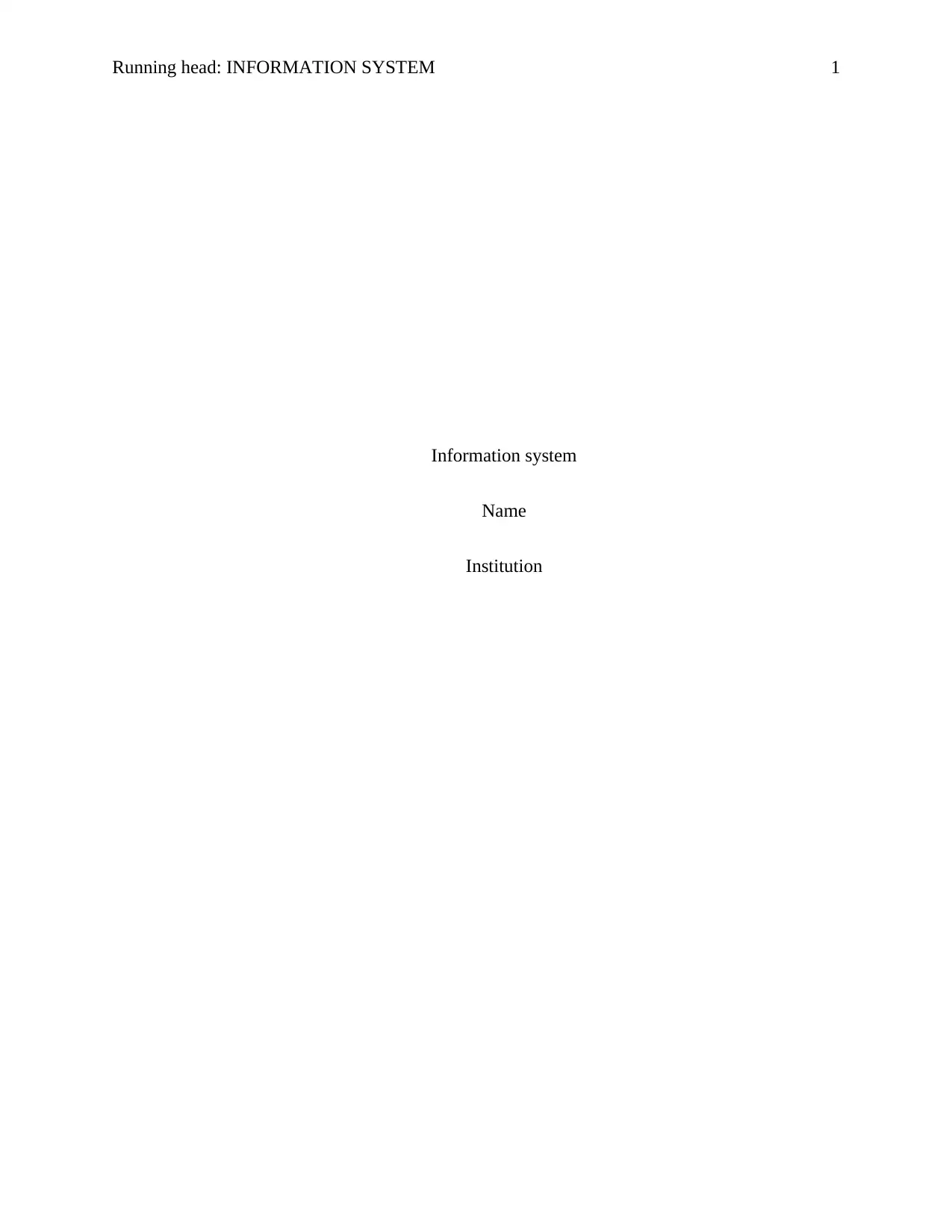
Running head: INFORMATION SYSTEM 1
Information system
Name
Institution
Information system
Name
Institution
Paraphrase This Document
Need a fresh take? Get an instant paraphrase of this document with our AI Paraphraser
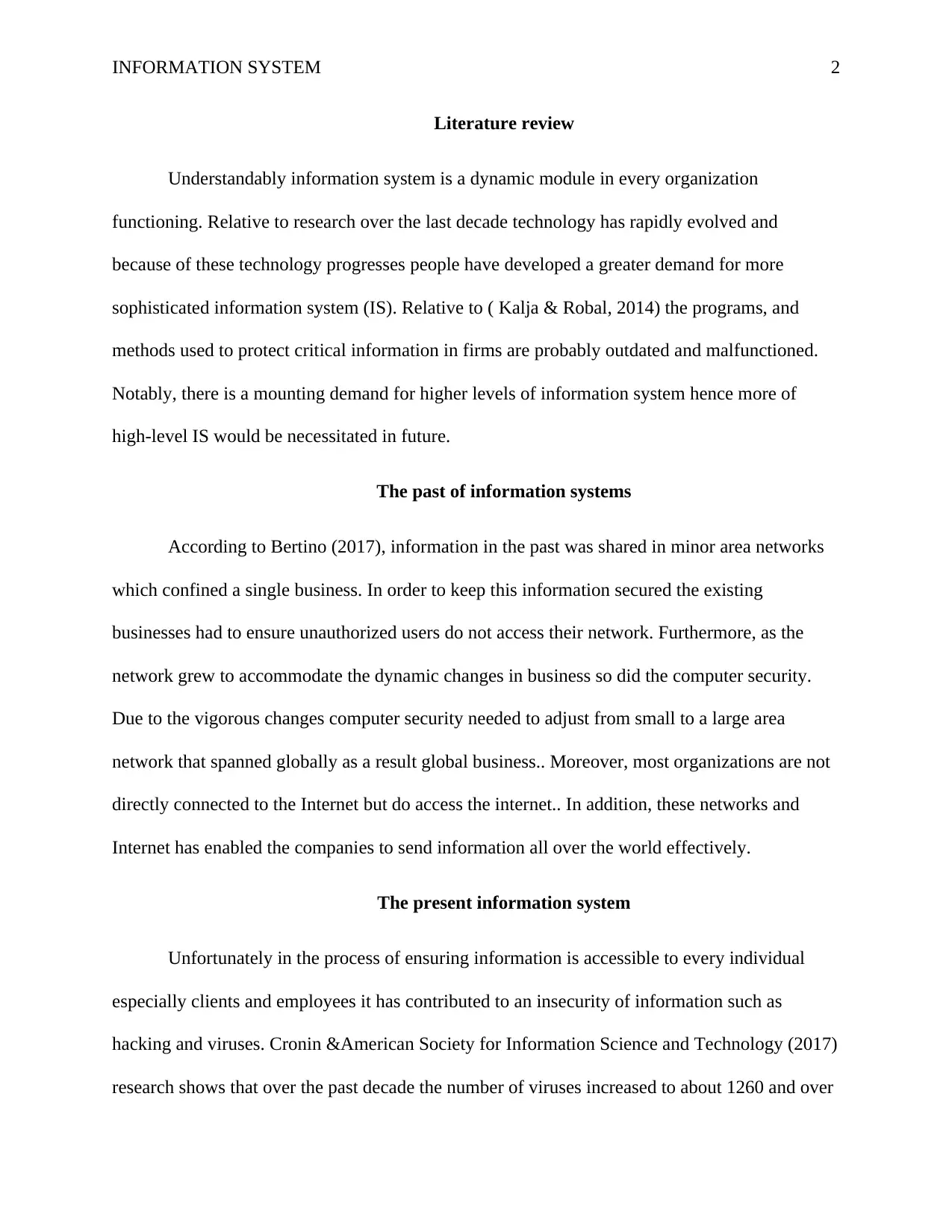
INFORMATION SYSTEM 2
Literature review
Understandably information system is a dynamic module in every organization
functioning. Relative to research over the last decade technology has rapidly evolved and
because of these technology progresses people have developed a greater demand for more
sophisticated information system (IS). Relative to ( Kalja & Robal, 2014) the programs, and
methods used to protect critical information in firms are probably outdated and malfunctioned.
Notably, there is a mounting demand for higher levels of information system hence more of
high-level IS would be necessitated in future.
The past of information systems
According to Bertino (2017), information in the past was shared in minor area networks
which confined a single business. In order to keep this information secured the existing
businesses had to ensure unauthorized users do not access their network. Furthermore, as the
network grew to accommodate the dynamic changes in business so did the computer security.
Due to the vigorous changes computer security needed to adjust from small to a large area
network that spanned globally as a result global business.. Moreover, most organizations are not
directly connected to the Internet but do access the internet.. In addition, these networks and
Internet has enabled the companies to send information all over the world effectively.
The present information system
Unfortunately in the process of ensuring information is accessible to every individual
especially clients and employees it has contributed to an insecurity of information such as
hacking and viruses. Cronin &American Society for Information Science and Technology (2017)
research shows that over the past decade the number of viruses increased to about 1260 and over
Literature review
Understandably information system is a dynamic module in every organization
functioning. Relative to research over the last decade technology has rapidly evolved and
because of these technology progresses people have developed a greater demand for more
sophisticated information system (IS). Relative to ( Kalja & Robal, 2014) the programs, and
methods used to protect critical information in firms are probably outdated and malfunctioned.
Notably, there is a mounting demand for higher levels of information system hence more of
high-level IS would be necessitated in future.
The past of information systems
According to Bertino (2017), information in the past was shared in minor area networks
which confined a single business. In order to keep this information secured the existing
businesses had to ensure unauthorized users do not access their network. Furthermore, as the
network grew to accommodate the dynamic changes in business so did the computer security.
Due to the vigorous changes computer security needed to adjust from small to a large area
network that spanned globally as a result global business.. Moreover, most organizations are not
directly connected to the Internet but do access the internet.. In addition, these networks and
Internet has enabled the companies to send information all over the world effectively.
The present information system
Unfortunately in the process of ensuring information is accessible to every individual
especially clients and employees it has contributed to an insecurity of information such as
hacking and viruses. Cronin &American Society for Information Science and Technology (2017)
research shows that over the past decade the number of viruses increased to about 1260 and over
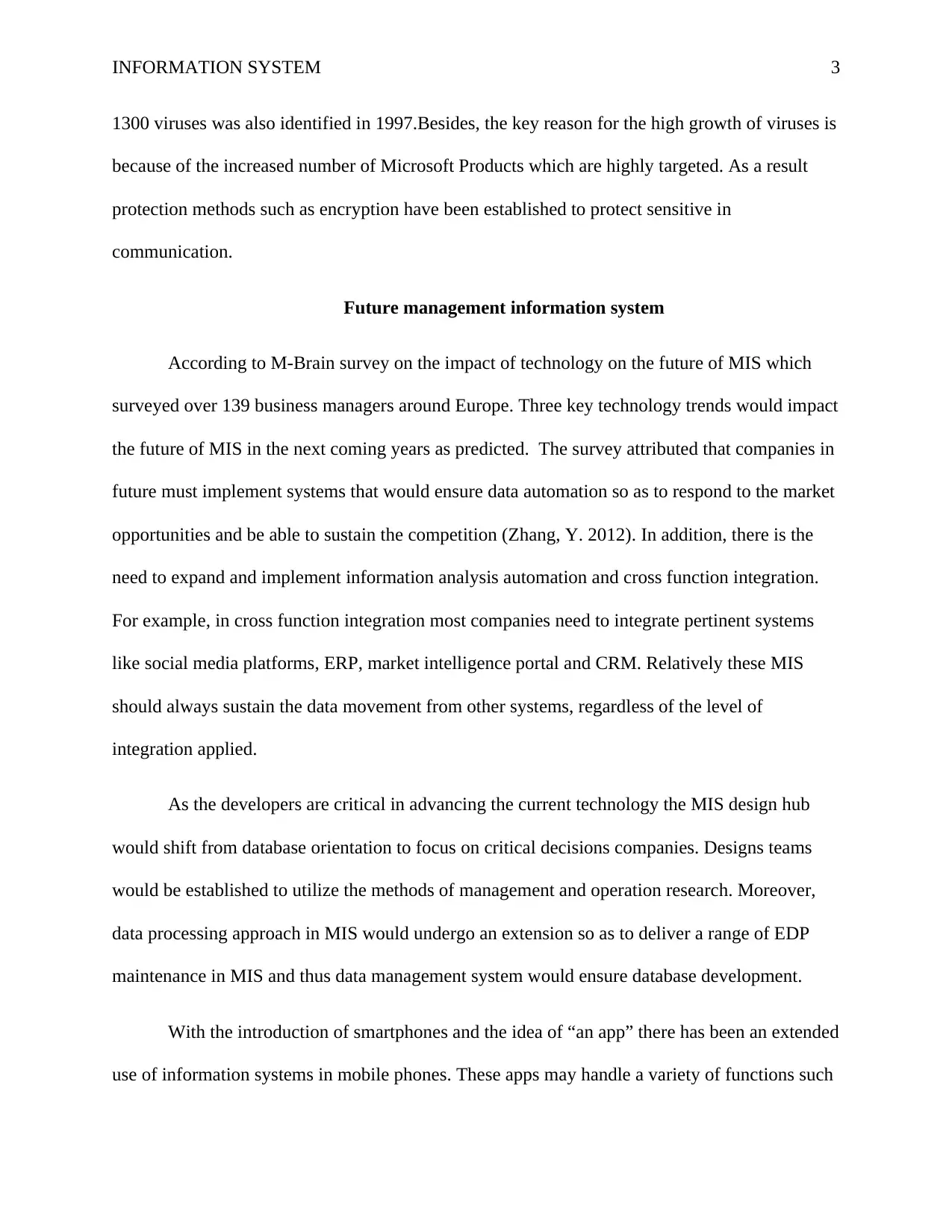
INFORMATION SYSTEM 3
1300 viruses was also identified in 1997.Besides, the key reason for the high growth of viruses is
because of the increased number of Microsoft Products which are highly targeted. As a result
protection methods such as encryption have been established to protect sensitive in
communication.
Future management information system
According to M-Brain survey on the impact of technology on the future of MIS which
surveyed over 139 business managers around Europe. Three key technology trends would impact
the future of MIS in the next coming years as predicted. The survey attributed that companies in
future must implement systems that would ensure data automation so as to respond to the market
opportunities and be able to sustain the competition (Zhang, Y. 2012). In addition, there is the
need to expand and implement information analysis automation and cross function integration.
For example, in cross function integration most companies need to integrate pertinent systems
like social media platforms, ERP, market intelligence portal and CRM. Relatively these MIS
should always sustain the data movement from other systems, regardless of the level of
integration applied.
As the developers are critical in advancing the current technology the MIS design hub
would shift from database orientation to focus on critical decisions companies. Designs teams
would be established to utilize the methods of management and operation research. Moreover,
data processing approach in MIS would undergo an extension so as to deliver a range of EDP
maintenance in MIS and thus data management system would ensure database development.
With the introduction of smartphones and the idea of “an app” there has been an extended
use of information systems in mobile phones. These apps may handle a variety of functions such
1300 viruses was also identified in 1997.Besides, the key reason for the high growth of viruses is
because of the increased number of Microsoft Products which are highly targeted. As a result
protection methods such as encryption have been established to protect sensitive in
communication.
Future management information system
According to M-Brain survey on the impact of technology on the future of MIS which
surveyed over 139 business managers around Europe. Three key technology trends would impact
the future of MIS in the next coming years as predicted. The survey attributed that companies in
future must implement systems that would ensure data automation so as to respond to the market
opportunities and be able to sustain the competition (Zhang, Y. 2012). In addition, there is the
need to expand and implement information analysis automation and cross function integration.
For example, in cross function integration most companies need to integrate pertinent systems
like social media platforms, ERP, market intelligence portal and CRM. Relatively these MIS
should always sustain the data movement from other systems, regardless of the level of
integration applied.
As the developers are critical in advancing the current technology the MIS design hub
would shift from database orientation to focus on critical decisions companies. Designs teams
would be established to utilize the methods of management and operation research. Moreover,
data processing approach in MIS would undergo an extension so as to deliver a range of EDP
maintenance in MIS and thus data management system would ensure database development.
With the introduction of smartphones and the idea of “an app” there has been an extended
use of information systems in mobile phones. These apps may handle a variety of functions such
⊘ This is a preview!⊘
Do you want full access?
Subscribe today to unlock all pages.

Trusted by 1+ million students worldwide
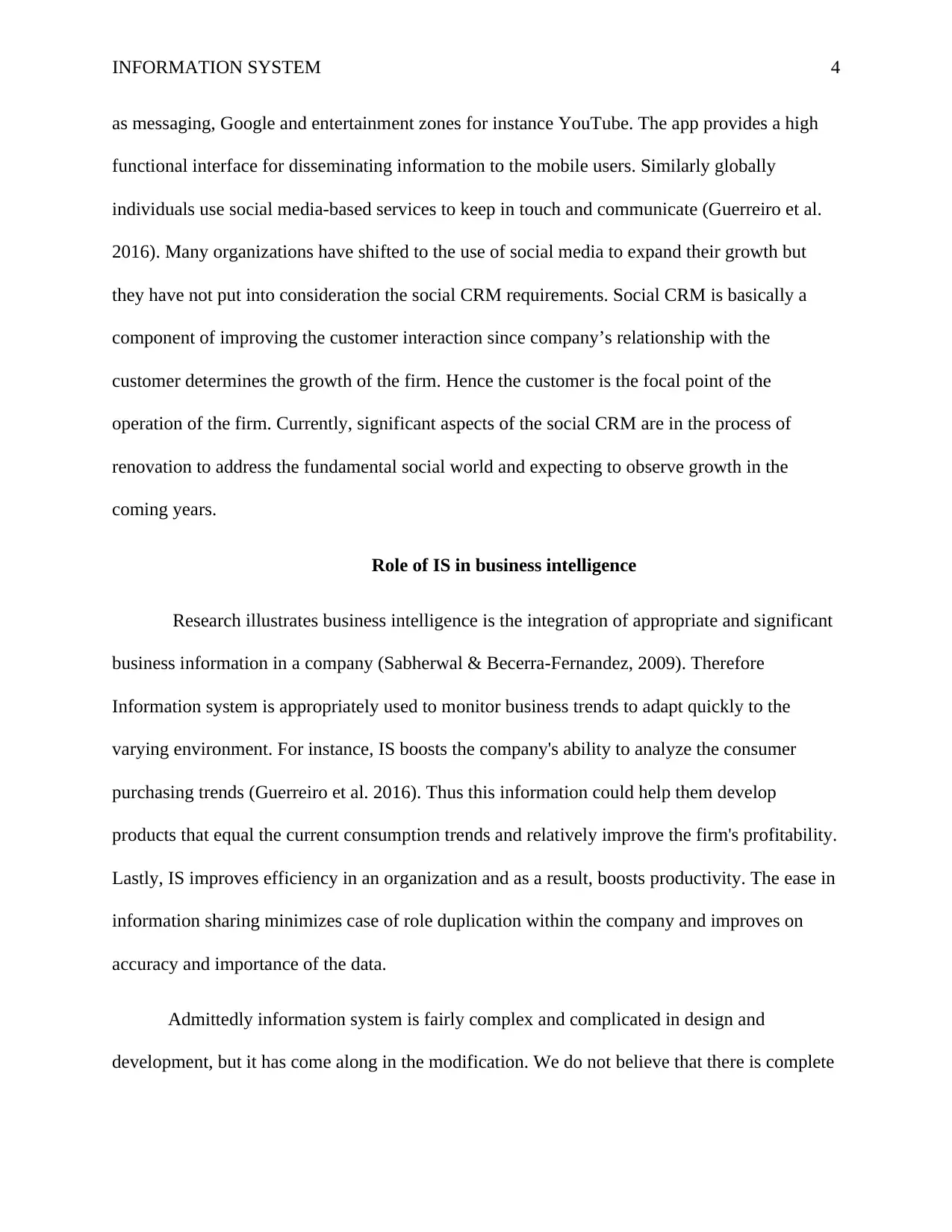
INFORMATION SYSTEM 4
as messaging, Google and entertainment zones for instance YouTube. The app provides a high
functional interface for disseminating information to the mobile users. Similarly globally
individuals use social media-based services to keep in touch and communicate (Guerreiro et al.
2016). Many organizations have shifted to the use of social media to expand their growth but
they have not put into consideration the social CRM requirements. Social CRM is basically a
component of improving the customer interaction since company’s relationship with the
customer determines the growth of the firm. Hence the customer is the focal point of the
operation of the firm. Currently, significant aspects of the social CRM are in the process of
renovation to address the fundamental social world and expecting to observe growth in the
coming years.
Role of IS in business intelligence
Research illustrates business intelligence is the integration of appropriate and significant
business information in a company (Sabherwal & Becerra-Fernandez, 2009). Therefore
Information system is appropriately used to monitor business trends to adapt quickly to the
varying environment. For instance, IS boosts the company's ability to analyze the consumer
purchasing trends (Guerreiro et al. 2016). Thus this information could help them develop
products that equal the current consumption trends and relatively improve the firm's profitability.
Lastly, IS improves efficiency in an organization and as a result, boosts productivity. The ease in
information sharing minimizes case of role duplication within the company and improves on
accuracy and importance of the data.
Admittedly information system is fairly complex and complicated in design and
development, but it has come along in the modification. We do not believe that there is complete
as messaging, Google and entertainment zones for instance YouTube. The app provides a high
functional interface for disseminating information to the mobile users. Similarly globally
individuals use social media-based services to keep in touch and communicate (Guerreiro et al.
2016). Many organizations have shifted to the use of social media to expand their growth but
they have not put into consideration the social CRM requirements. Social CRM is basically a
component of improving the customer interaction since company’s relationship with the
customer determines the growth of the firm. Hence the customer is the focal point of the
operation of the firm. Currently, significant aspects of the social CRM are in the process of
renovation to address the fundamental social world and expecting to observe growth in the
coming years.
Role of IS in business intelligence
Research illustrates business intelligence is the integration of appropriate and significant
business information in a company (Sabherwal & Becerra-Fernandez, 2009). Therefore
Information system is appropriately used to monitor business trends to adapt quickly to the
varying environment. For instance, IS boosts the company's ability to analyze the consumer
purchasing trends (Guerreiro et al. 2016). Thus this information could help them develop
products that equal the current consumption trends and relatively improve the firm's profitability.
Lastly, IS improves efficiency in an organization and as a result, boosts productivity. The ease in
information sharing minimizes case of role duplication within the company and improves on
accuracy and importance of the data.
Admittedly information system is fairly complex and complicated in design and
development, but it has come along in the modification. We do not believe that there is complete
Paraphrase This Document
Need a fresh take? Get an instant paraphrase of this document with our AI Paraphraser
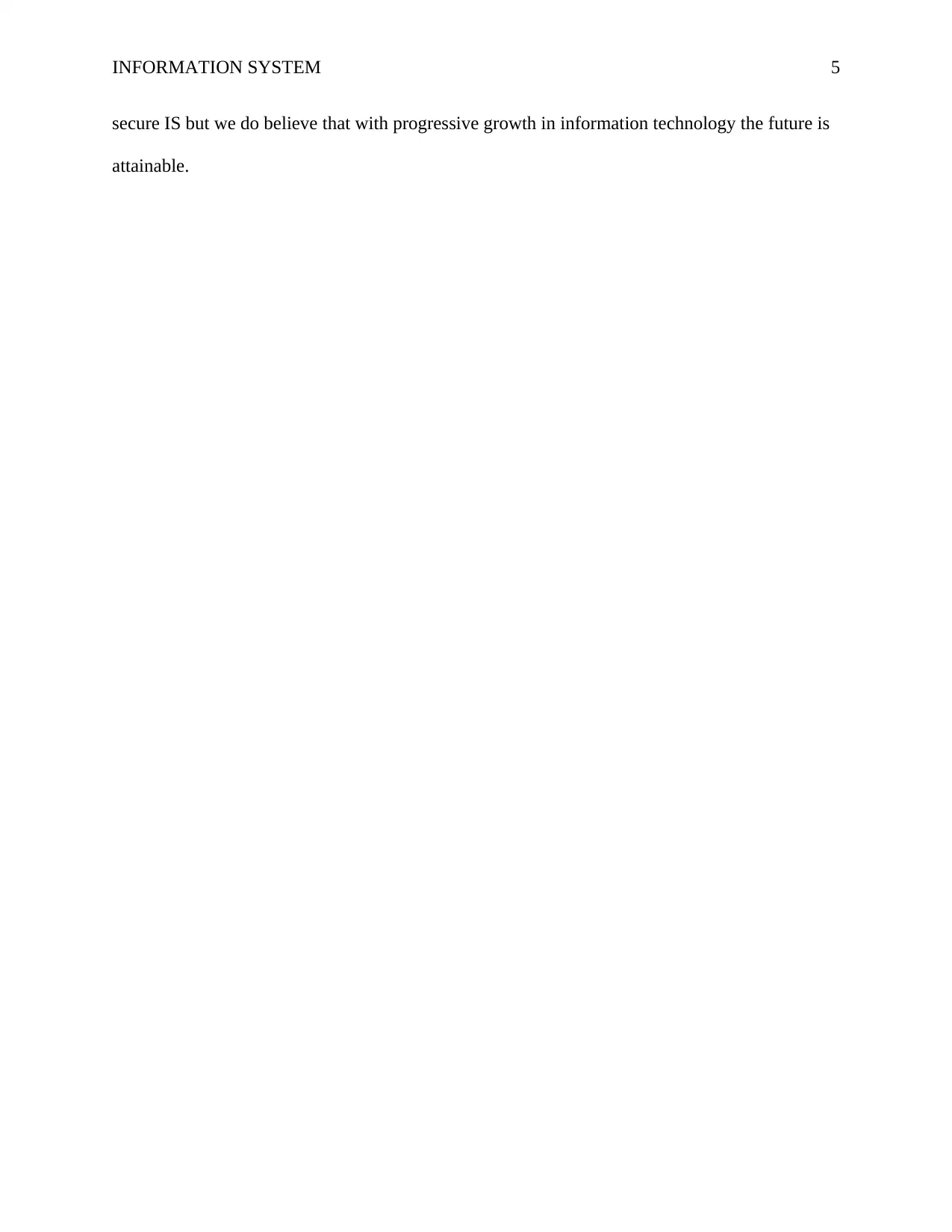
INFORMATION SYSTEM 5
secure IS but we do believe that with progressive growth in information technology the future is
attainable.
secure IS but we do believe that with progressive growth in information technology the future is
attainable.
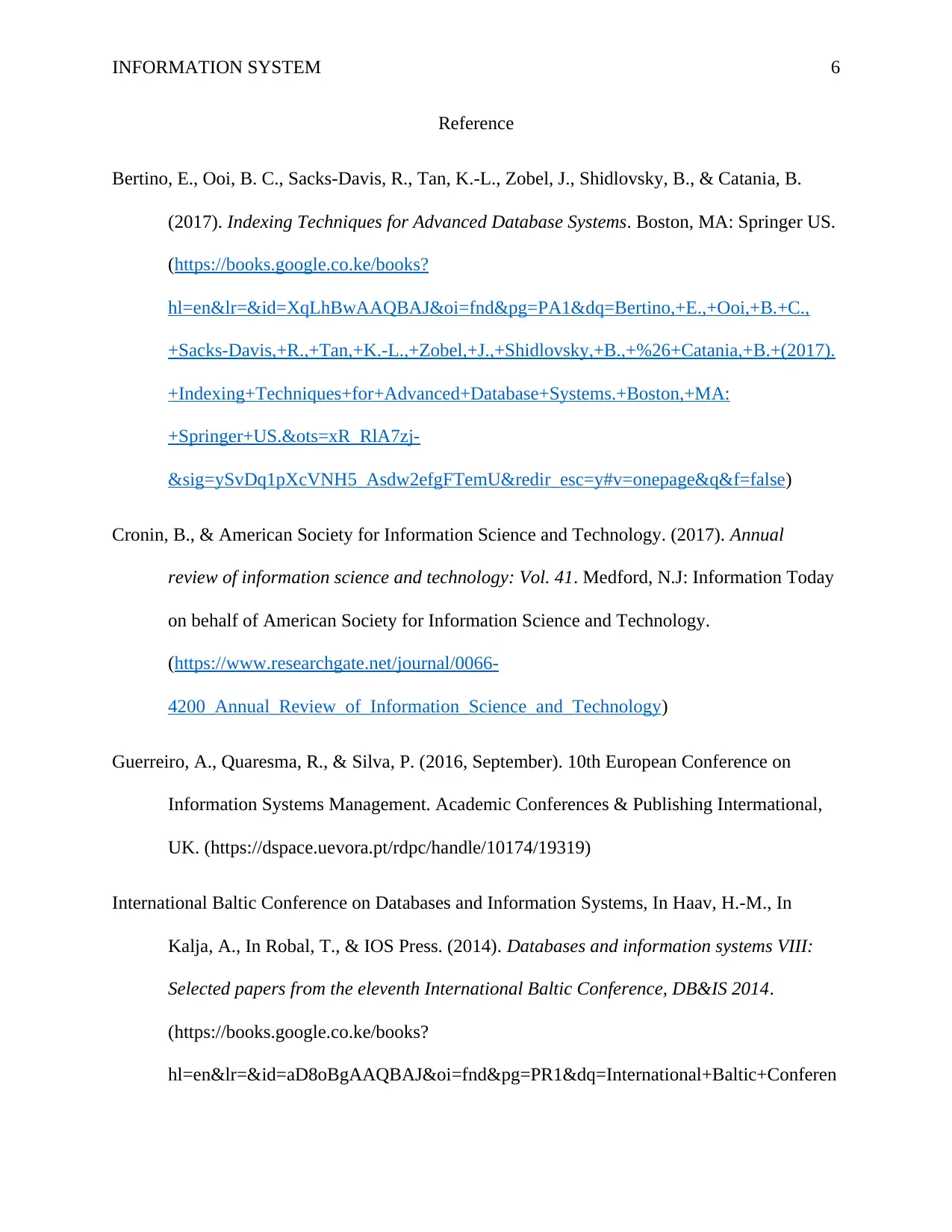
INFORMATION SYSTEM 6
Reference
Bertino, E., Ooi, B. C., Sacks-Davis, R., Tan, K.-L., Zobel, J., Shidlovsky, B., & Catania, B.
(2017). Indexing Techniques for Advanced Database Systems. Boston, MA: Springer US.
(https://books.google.co.ke/books?
hl=en&lr=&id=XqLhBwAAQBAJ&oi=fnd&pg=PA1&dq=Bertino,+E.,+Ooi,+B.+C.,
+Sacks-Davis,+R.,+Tan,+K.-L.,+Zobel,+J.,+Shidlovsky,+B.,+%26+Catania,+B.+(2017).
+Indexing+Techniques+for+Advanced+Database+Systems.+Boston,+MA:
+Springer+US.&ots=xR_RlA7zj-
&sig=ySvDq1pXcVNH5_Asdw2efgFTemU&redir_esc=y#v=onepage&q&f=false)
Cronin, B., & American Society for Information Science and Technology. (2017). Annual
review of information science and technology: Vol. 41. Medford, N.J: Information Today
on behalf of American Society for Information Science and Technology.
(https://www.researchgate.net/journal/0066-
4200_Annual_Review_of_Information_Science_and_Technology)
Guerreiro, A., Quaresma, R., & Silva, P. (2016, September). 10th European Conference on
Information Systems Management. Academic Conferences & Publishing Intermational,
UK. (https://dspace.uevora.pt/rdpc/handle/10174/19319)
International Baltic Conference on Databases and Information Systems, In Haav, H.-M., In
Kalja, A., In Robal, T., & IOS Press. (2014). Databases and information systems VIII:
Selected papers from the eleventh International Baltic Conference, DB&IS 2014.
(https://books.google.co.ke/books?
hl=en&lr=&id=aD8oBgAAQBAJ&oi=fnd&pg=PR1&dq=International+Baltic+Conferen
Reference
Bertino, E., Ooi, B. C., Sacks-Davis, R., Tan, K.-L., Zobel, J., Shidlovsky, B., & Catania, B.
(2017). Indexing Techniques for Advanced Database Systems. Boston, MA: Springer US.
(https://books.google.co.ke/books?
hl=en&lr=&id=XqLhBwAAQBAJ&oi=fnd&pg=PA1&dq=Bertino,+E.,+Ooi,+B.+C.,
+Sacks-Davis,+R.,+Tan,+K.-L.,+Zobel,+J.,+Shidlovsky,+B.,+%26+Catania,+B.+(2017).
+Indexing+Techniques+for+Advanced+Database+Systems.+Boston,+MA:
+Springer+US.&ots=xR_RlA7zj-
&sig=ySvDq1pXcVNH5_Asdw2efgFTemU&redir_esc=y#v=onepage&q&f=false)
Cronin, B., & American Society for Information Science and Technology. (2017). Annual
review of information science and technology: Vol. 41. Medford, N.J: Information Today
on behalf of American Society for Information Science and Technology.
(https://www.researchgate.net/journal/0066-
4200_Annual_Review_of_Information_Science_and_Technology)
Guerreiro, A., Quaresma, R., & Silva, P. (2016, September). 10th European Conference on
Information Systems Management. Academic Conferences & Publishing Intermational,
UK. (https://dspace.uevora.pt/rdpc/handle/10174/19319)
International Baltic Conference on Databases and Information Systems, In Haav, H.-M., In
Kalja, A., In Robal, T., & IOS Press. (2014). Databases and information systems VIII:
Selected papers from the eleventh International Baltic Conference, DB&IS 2014.
(https://books.google.co.ke/books?
hl=en&lr=&id=aD8oBgAAQBAJ&oi=fnd&pg=PR1&dq=International+Baltic+Conferen
⊘ This is a preview!⊘
Do you want full access?
Subscribe today to unlock all pages.

Trusted by 1+ million students worldwide
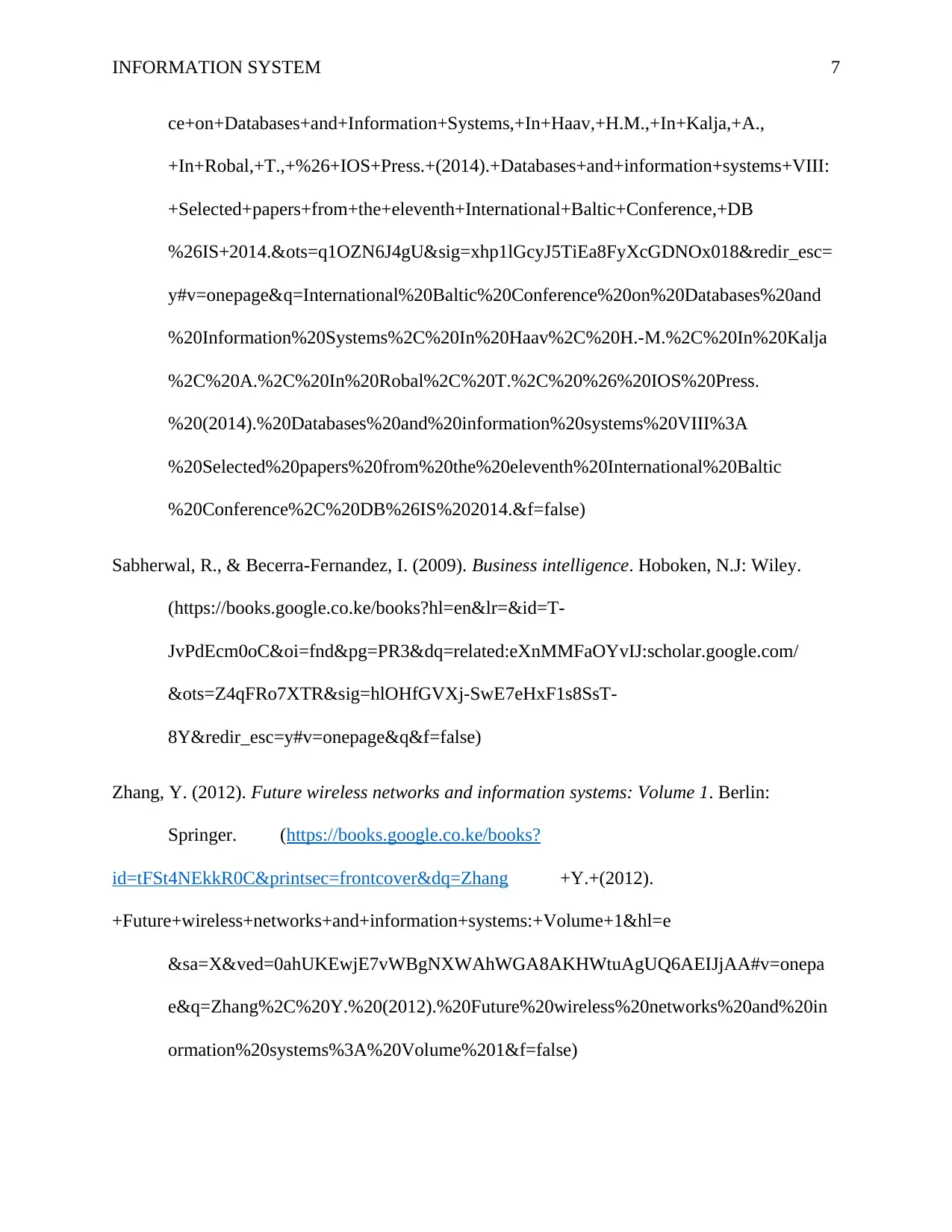
INFORMATION SYSTEM 7
ce+on+Databases+and+Information+Systems,+In+Haav,+H.M.,+In+Kalja,+A.,
+In+Robal,+T.,+%26+IOS+Press.+(2014).+Databases+and+information+systems+VIII:
+Selected+papers+from+the+eleventh+International+Baltic+Conference,+DB
%26IS+2014.&ots=q1OZN6J4gU&sig=xhp1lGcyJ5TiEa8FyXcGDNOx018&redir_esc=
y#v=onepage&q=International%20Baltic%20Conference%20on%20Databases%20and
%20Information%20Systems%2C%20In%20Haav%2C%20H.-M.%2C%20In%20Kalja
%2C%20A.%2C%20In%20Robal%2C%20T.%2C%20%26%20IOS%20Press.
%20(2014).%20Databases%20and%20information%20systems%20VIII%3A
%20Selected%20papers%20from%20the%20eleventh%20International%20Baltic
%20Conference%2C%20DB%26IS%202014.&f=false)
Sabherwal, R., & Becerra-Fernandez, I. (2009). Business intelligence. Hoboken, N.J: Wiley.
(https://books.google.co.ke/books?hl=en&lr=&id=T-
JvPdEcm0oC&oi=fnd&pg=PR3&dq=related:eXnMMFaOYvIJ:scholar.google.com/
&ots=Z4qFRo7XTR&sig=hlOHfGVXj-SwE7eHxF1s8SsT-
8Y&redir_esc=y#v=onepage&q&f=false)
Zhang, Y. (2012). Future wireless networks and information systems: Volume 1. Berlin:
Springer. (https://books.google.co.ke/books?
id=tFSt4NEkkR0C&printsec=frontcover&dq=Zhang +Y.+(2012).
+Future+wireless+networks+and+information+systems:+Volume+1&hl=e
&sa=X&ved=0ahUKEwjE7vWBgNXWAhWGA8AKHWtuAgUQ6AEIJjAA#v=onepa
e&q=Zhang%2C%20Y.%20(2012).%20Future%20wireless%20networks%20and%20in
ormation%20systems%3A%20Volume%201&f=false)
ce+on+Databases+and+Information+Systems,+In+Haav,+H.M.,+In+Kalja,+A.,
+In+Robal,+T.,+%26+IOS+Press.+(2014).+Databases+and+information+systems+VIII:
+Selected+papers+from+the+eleventh+International+Baltic+Conference,+DB
%26IS+2014.&ots=q1OZN6J4gU&sig=xhp1lGcyJ5TiEa8FyXcGDNOx018&redir_esc=
y#v=onepage&q=International%20Baltic%20Conference%20on%20Databases%20and
%20Information%20Systems%2C%20In%20Haav%2C%20H.-M.%2C%20In%20Kalja
%2C%20A.%2C%20In%20Robal%2C%20T.%2C%20%26%20IOS%20Press.
%20(2014).%20Databases%20and%20information%20systems%20VIII%3A
%20Selected%20papers%20from%20the%20eleventh%20International%20Baltic
%20Conference%2C%20DB%26IS%202014.&f=false)
Sabherwal, R., & Becerra-Fernandez, I. (2009). Business intelligence. Hoboken, N.J: Wiley.
(https://books.google.co.ke/books?hl=en&lr=&id=T-
JvPdEcm0oC&oi=fnd&pg=PR3&dq=related:eXnMMFaOYvIJ:scholar.google.com/
&ots=Z4qFRo7XTR&sig=hlOHfGVXj-SwE7eHxF1s8SsT-
8Y&redir_esc=y#v=onepage&q&f=false)
Zhang, Y. (2012). Future wireless networks and information systems: Volume 1. Berlin:
Springer. (https://books.google.co.ke/books?
id=tFSt4NEkkR0C&printsec=frontcover&dq=Zhang +Y.+(2012).
+Future+wireless+networks+and+information+systems:+Volume+1&hl=e
&sa=X&ved=0ahUKEwjE7vWBgNXWAhWGA8AKHWtuAgUQ6AEIJjAA#v=onepa
e&q=Zhang%2C%20Y.%20(2012).%20Future%20wireless%20networks%20and%20in
ormation%20systems%3A%20Volume%201&f=false)
1 out of 7
Related Documents
Your All-in-One AI-Powered Toolkit for Academic Success.
+13062052269
info@desklib.com
Available 24*7 on WhatsApp / Email
![[object Object]](/_next/static/media/star-bottom.7253800d.svg)
Unlock your academic potential
Copyright © 2020–2025 A2Z Services. All Rights Reserved. Developed and managed by ZUCOL.




